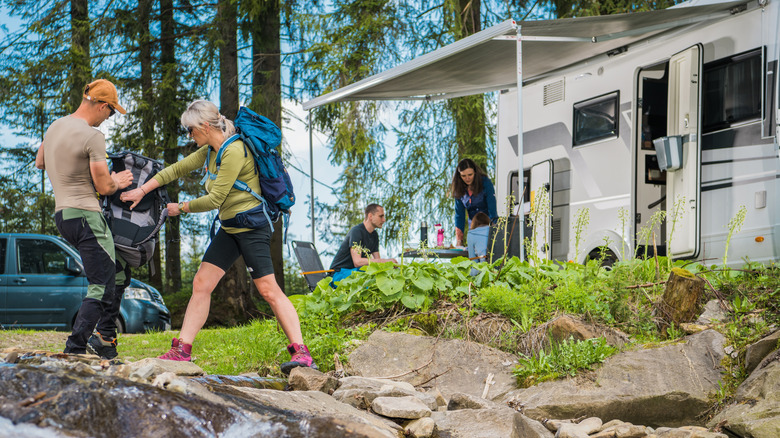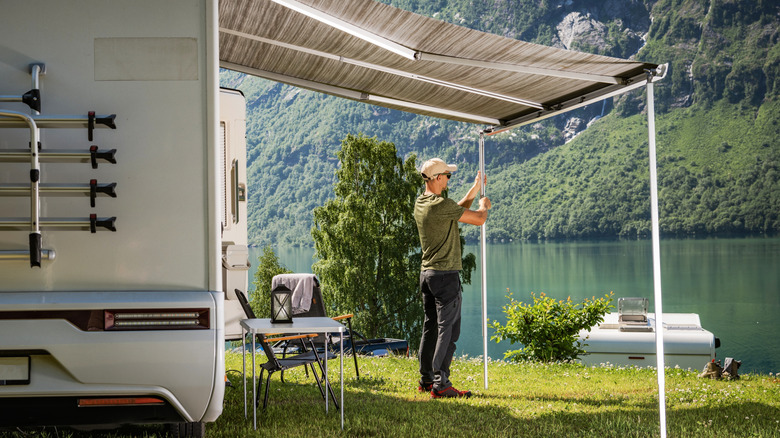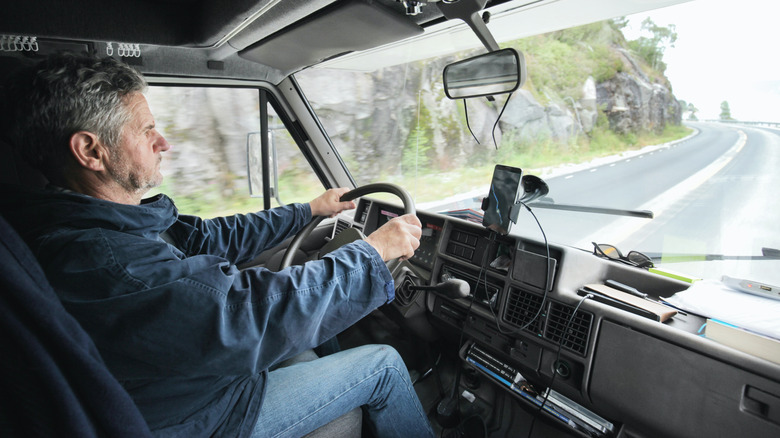This Easy-To-Make RV Mistake Can Quickly Become Dangerous When Driving Or Camping
We may receive a commission on purchases made from links.
There are tons of benefits to RV living: the freedom to travel without sacrificing comfort, the ability to bring your home with you pretty much anywhere you go, and the opportunity to enjoy modern conveniences even in the most remote locations. From modern kitchen appliances to comfortable beds, ample storage, and even outdoor furniture, most modern RVs come fully-equipped with features that make roadtripping a whole lot more enjoyable. Because, let's face it, nothing's better than exploring new destinations with your favorite coffee maker and cozy bedding in tow. That said, among these beloved conveniences, there's one simple item that's widely recognized as one of the most vital additions for setting up the perfect RV campground: awnings.
Generally considered a necessity — they protect you from both rain and sun when you need them, and they're great for creating extra outdoor living space. Awnings enhance every RV experience. However, at the same time, they can also be a little easy to overlook and forget about. After all, despite being such a prominent feature of many RV setups, it's actually pretty common to see new RV owners forget about them completely and leave them accidentally unsecured before hitting the road.
And even though this mistake might seem like a minor oversight, the reality is that unsecured and unattended awnings can quickly turn into a dangerous liability if the conditions are right (or wrong, in this case). In fact, an unsecured awning can actually pose some pretty serious risks to both your RV and others around you. This includes severe damage to your RV's structure, dangerous road hazards for other drivers, and serious injuries to pedestrians or nearby campers.
Weather changes can destroy unattended awnings at camp
In most cases, awnings get damaged at camp when RV owners accidentally (or knowingly) leave their site for activities or overnight trips without properly securing their setup. This is primarily due to sudden weather changes — which can happen very quickly, especially in mountainous or coastal areas where you might be camping — that can turn a perfectly calm morning into an afternoon windstorm that completely tears your awning apart. Strong winds can easily flip an extended awning completely over your RV, ripping it from its mounting points and potentially damaging your vehicle's roof or sides. At the same time, a loose awning can also break the windows on any neighboring vehicles and even injure nearby campers.
As such, the most important thing you can do to help keep your RV safe and functional during your camping trip is to always secure your awning and check that it's fully fastened down as part of your pre-departure routine — just like disconnecting utilities or doing a quick walk-around inspection of your campsite. Whether you're leaving for an hour or on an overnight excursion, making sure that you always retract your awning completely, or that you tie it down securely with the proper straps and stakes, can save you a massive headache (and an even more expensive insurance claim).
Unsecured awnings can also create dangerous driving situations
Away from the campsite, the most serious awning-related accidents typically happen while you're actually driving your RV. After all, when an awning unexpectedly extends at highway speeds, it creates an immediate safety hazard that can be incredibly hard to get back under control. The force of wind can rip the awning from its mounting brackets, sending heavy metal supports and fabric into traffic behind you — which can lead to damage to other vehicles, cause accidents, or even injure other drivers.
Adding to the danger, an extended awning also dramatically affects your RV's aerodynamics due to the increased drag. The extra surface area can catch wind similarly to a ship's sail, and potentially cause your vehicle to swerve or become difficult to control. What's even more concerning is that many drivers don't actually realize that their awning has come loose until they see it flapping in their mirrors or hear the terrifying sound of metal scraping against the RV's side. Even a partially loose awning poses risks, which is why it's so important to make sure you've rolled it up and tied it back properly.
That said, it's also worth investing in quality awning travel locks while preparing for your RV road trip. Not only are they affordable, but most models are also pretty easy to install, and can provide added protection against any accidental deployment.


